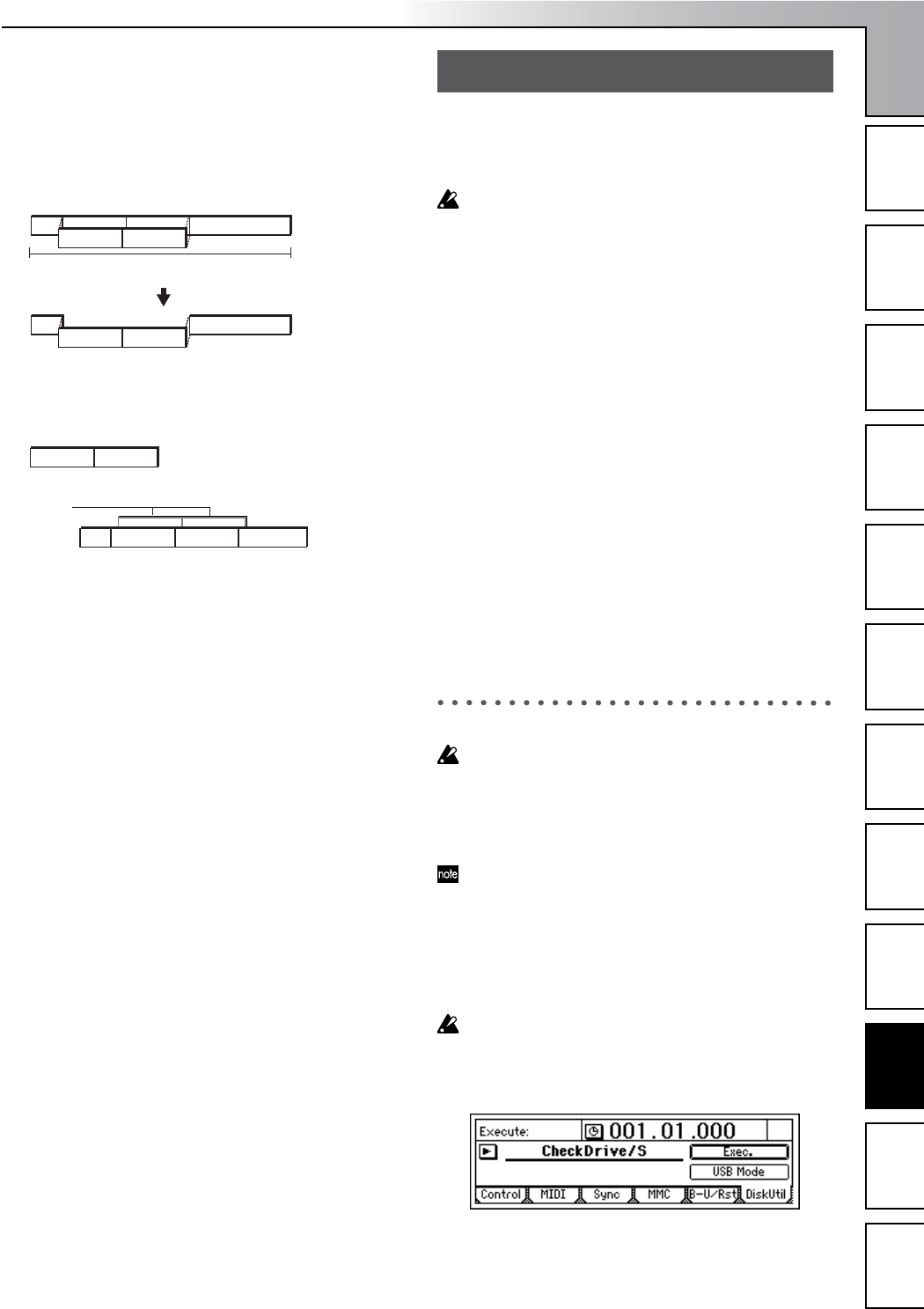
Operation
77
Song and Locate
MixerEffects
Modeling mode
Rhythm
The Recorder
MasteringDataDriveUSBMIDIUpgrading
the system
To erase A and B that remain from the first take, and
recover disk space
Execute the Optimize Track command on track 1 from
the beginning to the end of the song. When this is exe-
cuted, only the audio data of the 1st take Intro, 2nd take
A’, 2nd take B’, and 1st take Break will be kept. This
means that the 1st take A and 1st take B data will no
longer occupy disk space.
Example 3: You recorded A and B on track 1 as the first
take. As the second take, you overwrite-recorded the
Intro, A’, B’, and Break.
In this case, the first take A and B remain “beneath” A’
and B’, but since the audio data of take 1 is not used at
all once you finished recording take 2, there is no need
to execute the optimize command.
Deleting the Undo data
Even if you use the drive space efficiently as described
above (examples 1, 2, 3), the old data will be kept on the
drive for use by the Undo function.
If you want to delete this Undo data, you can restart the
D1200. When the D1200 is restarted, all Undo data will
be deleted, and the unused drive space will be recov-
ered.
Sharing event data
If you use the Copy Track operation to copy track data
to another track (e.g., virtual track) or another song, this
audio data will be shared, so that the drive capacity will
not decrease. However if you execute the Optimize
Track operation on the copy-destination or copy-source
track, new audio data will be created, and this will mean
that a greater amount of drive capacity will be used than
before the operation was executed.
In the case of example 2, if you copy the first take to
another track before you record the second time, execut-
ing the Optimize Track operation will not delete the “A”
and “B” regions of the first take, and audio data for the
“Intro” and “Break” regions will be newly created,
meaning that a greater amount of drive capacity will be
used.
What is USB?
USB stands for Universal Serial Bus, and is an interface
for transferring data between a computer and periph-
eral devices.
USB peripheral devices such as hard disks or CD-R/RW
drives cannot be connected to the D1200.
The D1200 has a [USB] connector which you can connect di-
rectly to your computer, and save data to your computer
from the USB drive area of the D1200’s internal hard disk.
Using the USB drive, the following types of data can be
saved to your computer or loaded from your computer.
Song data
This is data for each track, as well as data such as pan
and effect settings. Since this data is in the D1200’s own
unique format, it cannot be played or edited on your
computer or any device other than the D1200. In order
to play this data, you must restore it to the D1200.
Effect user data
This is the data that has been stored in the effect pro-
gram user area.
Since this data is in the D1200’s own unique format, it
cannot be edited on your computer.
In order to use this effect data, you must restore it to the
D1200.
WAV files: WAV format audio files
This is audio track data that was copied to the clipboard.
1. Saving data to your computer
Do not format the D1200’s hard disk from your compu-
ter. The hard disk may be formatted only by the D1200
itself.
In order to use the D1200 with Windows 98, you must install
a device driver. For details on obtaining and installing the
device driver, refer to the Korg website (www.korg.com).
The computer screen will differ depending on your sys-
tem. The screens shown here are for Windows XP.
Windows users (Windows Me/2000 or later)
1 Use a USB cable to connect the D1200 to your computer.
Connect the USB cable from your computer to the
D1200’s [USB] connector. Make sure that the connector
is oriented correctly, and press it all the way in.
Before you make connections, turn on your computer
and start up the operating system.
2 Access the “USB Mode” screen.
In the [SYSTEM/USB] “DiskUtil” tab page, select “USB
Mode” and press the [ENTER] key.
“OptimizeTrack”
IN OUT
BA
Intro
Break
Intro
B'A'
Break
B'A'
2nd take
1st take
Intro
B'A' Break
BA
1st take
USB
USB


















